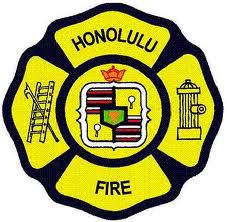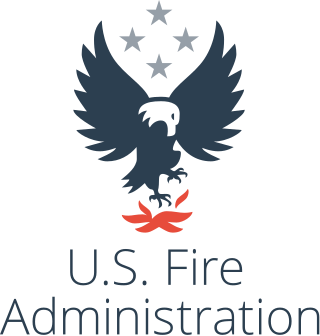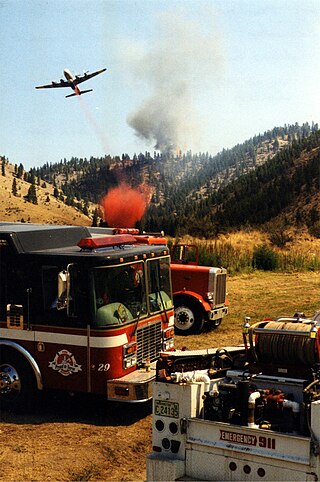
The Centers for Disease Control and Prevention (CDC) is the national public health agency of the United States. It is a United States federal agency under the Department of Health and Human Services, and is headquartered in Atlanta, Georgia.

A firefighter is a first responder trained in firefighting, primarily to control and extinguish fires that threaten life and property, as well as to rescue persons from confinement or dangerous situations. Male firefighters are sometimes referred to as firemen.

The National Institute for Occupational Safety and Health is the United States federal agency responsible for conducting research and making recommendations for the prevention of work-related injury and illness. NIOSH is part of the Centers for Disease Control and Prevention (CDC) within the U.S. Department of Health and Human Services. Despite its name, it is not part of either the National Institutes of Health nor OSHA. Its current director is John Howard.

The Honolulu Fire Department (HFD) provides fire protection and first responder emergency medical services to the City & County of Honolulu, Hawaii, United States, under the jurisdiction of the Mayor of Honolulu. Founded on December 27, 1850, by Kamehameha III and Alexander Cartwright, the Honolulu Fire Department serves and protects the entire island of O'ahu, covering over 600 square miles (1,600 km2) of territory, home to more than 880,000 residents and over 4 million annual visitors.

Fire safety is the set of practices intended to reduce destruction caused by fire. Fire safety measures include those that are intended to prevent the ignition of an uncontrolled fire and those that are used to limit the spread and impact of a fire.
Firefighting jargon includes a diverse lexicon of both common and idiosyncratic terms. One problem that exists in trying to create a list such as this is that much of the terminology used by a particular department is specifically defined in their particular standing operating procedures, such that two departments may have completely different terms for the same thing. For example, depending on whom one asks, a safety team may be referred to as a standby, a RIT or RIG or RIC, or a FAST. Furthermore, a department may change a definition within its SOP, such that one year it may be RIT, and the next RIG or RIC.
The National Fire Incident Reporting System (NFIRS) is a system established by the National Fire Data Center of the United States Fire Administration (USFA), a division of the Federal Emergency Management Agency. The System was established after the 1973 National Commission on Fire Prevention and Control report, America Burning, led to passage of the Federal Fire Prevention and Control Act of 1974, which authorizes the USFA to gather and analyze information on the magnitude of the Nation's fire problem, as well as its detailed characteristics and trends. The Act further authorizes the USFA to develop uniform data reporting methods, and to encourage and assist state agencies in developing and reporting data.

Aircraft rescue and firefighting (ARFF) is a type of firefighting that involves the emergency response, mitigation, evacuation, and rescue of passengers and crew of aircraft involved in aviation accidents and incidents.

The United States Fire Administration (USFA) is a division of the Federal Emergency Management Agency (FEMA) located in Frederick County, Maryland, near Emmitsburg. Per the official website, "the mission of the U.S. Fire Administration is to support and strengthen fire and emergency medical services (EMS) and stakeholders to prepare for, prevent, mitigate and respond to all hazards".

Wildfire suppression is a range of firefighting tactics used to suppress wildfires. Firefighting efforts depend on many factors such as the available fuel, the local atmospheric conditions, the features of the terrain, and the size of the wildfire. Because of this wildfire suppression in wild land areas usually requires different techniques, equipment, and training from the more familiar structure fire fighting found in populated areas. Working in conjunction with specially designed aerial firefighting aircraft, fire engines, tools, firefighting foams, fire retardants, and using various firefighting techniques, wildfire-trained crews work to suppress flames, construct fire lines, and extinguish flames and areas of heat in order to protect resources and natural wilderness. Wildfire suppression also addresses the issues of the wildland–urban interface, where populated areas border with wild land areas.
Marine safety is one of the eleven missions of the United States Coast Guard.
The National Fire Academy (NFA) is one of two schools in the United States operated by the Federal Emergency Management Agency (FEMA) at the National Emergency Training Center (NETC) in Emmitsburg, Maryland. Operated and governed by the United States Fire Administration (USFA) as part of the U.S. Department of Homeland Security (DHS), the NFA is the country’s preeminent federal fire training and education institution. The original purpose of the NFA as detailed in a 1973 report to Congress was to "function as the core of the Nation's efforts in fire service education—feeding out model programs, curricula, and information..."

Wildfires are outdoor fires that occur in the wilderness or other vast spaces. Other common names associated with wildfires are brushfire and forest fire. Since wildfires can occur anywhere on the planet, except for Antarctica, they pose a threat to civilizations and wildlife alike. In terms of emergency management, wildfires can be particularly devastating. Given their ability to destroy large areas of entire ecosystems, there must be a contingency plan in effect to be as prepared as possible in case of a wildfire and to be adequately prepared to handle the aftermath of one as well.

Occupational safety and health (OSH) or occupational health and safety (OHS) is a multidisciplinary field concerned with the safety, health, and welfare of people at work. OSH is related to the fields of occupational medicine and occupational hygiene and aligns with workplace health promotion initiatives. OSH also protects all the general public who may be affected by the occupational environment.
America Burning: The Report of The National Commission on Fire Prevention and Control is a 1973 report written by the National Commission on Fire Prevention and Control to evaluate fire loss in the United States and to make recommendation to reduce loss and increase safety of citizens and firefighting personnel. The report concluded that fire prevention and fire safety education for the public were critical to reducing the losses associated with fires, and that firefighters also needed to be better educated for their jobs in fighting fires. As a result of the report, in 1974 the United States Congress passed the Federal Fire Prevention and Control Act of 1974 leading to the formation of the U.S. Fire Administration, the National Fire Academy, the National Fire Incident Reporting System, and the Center for Fire Research within the National Bureau of Standards. One of the most critical findings of the report was that the high death rate among American firefighters should be addressed. As a result of this report, fire fighting agencies planned life and property loss-reduction strategies for handling incidents before they occurred.

AIDS amendments of 1988, better known as the Health Omnibus Programs Extension (HOPE) Act of 1988, is a United States statute amending the Public Health Service Act. The Acquired Immune Deficiency Syndrome amendments were compiled as Title II - Programs with Respect to Acquired Immune Deficiency Syndrome within the HOPE Act of 1988. The Title II Act appropriated federal funding for Acquired Immune Deficiency Syndrome (AIDS) education, prevention, research, and testing. The U.S. legislative title provisioned the establishment of the presidentially appointed National Commission on AIDS. The S. 2889 legislation was passed by the 100th U.S. Congressional session and signed by President Ronald Reagan on November 4, 1988.

Fire Research and Safety Act of 1968 was a declaration for a panoptic fire research and safety program advocated by President Lyndon Johnson on February 16, 1967. The Act of Congress established a National Commission on Fire Prevention and Control while encompassing more effective measures for fire hazards protection with the potentiality of death, injury, and damage to property. The U.S. statute petitioned a nationwide collection of comprehensive fire data with emphasis on a United States fire research program, fire safety education and training programs, demonstrations of new approaches and improvements in fire control and prevention resulting in the reduction of death, personal injury, and property damage.

Hotel and Motel Fire Safety Act of 1990 was established to acknowledge the evolving apprehension of fire safety criteria for the hospitality industry. The United States federal statute was an amendment to the Federal Fire Prevention and Control Act of 1974 implementing an adjunct promoting fire and life safety decrees for domiciles providing public accommodations.

The New Jersey Forest Fire Service (NJFFS) is an agency within the New Jersey Department of Environmental Protection. Founded in 1906 with a focus on wildland fire suppression and fire protection, the Forest Fire Service is the largest firefighting department within the state of New Jersey in the United States with 85 full-time professional firefighting personnel, and approximately 2,000 trained part-time on-call wildland firefighters throughout the state. Its mission is to protect "life and property, as well as the state's natural resources, from wildfire".

David Allen Lucht is an American engineer and fire safety expert. His career was devoted to public service in government, academia and the nonprofit sector. He served as the Ohio State Fire Marshal; the first presidential appointee to serve in the United States Fire Administration and the inaugural head of the graduate degree fire protection engineering program at Worcester Polytechnic Institute, where he served for 25 years














